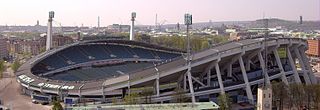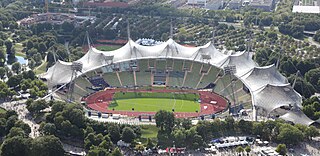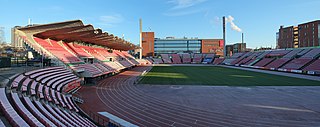
Ullevi, sometimes known as Nya Ullevi, is a multi-purpose stadium in Gothenburg, Sweden. It was built for the 1958 FIFA World Cup, but since then has also hosted the World Allround Speed Skating Championships six times; the 1995 World Championships in Athletics and the 2006 European Athletics Championships; the UEFA Cup Winners' Cup finals in 1983 and 1990; the UEFA Euro 1992 final, the UEFA Cup final in 2004; and annually hosted the opening ceremony of the Gothia Cup, the world's largest football tournament in terms of the number of participants. IFK Göteborg has also played two UEFA Cup finals at the stadium, in 1982 and 1987, but then as "home game" in a home and away final. The stadium has hosted several events, including football, ice hockey, boxing, racing, athletics and concerts.

The Olympiastadion is a sports stadium at Olympiapark Berlin in Berlin, Germany. It was originally built by Werner March for the 1936 Summer Olympics. During the Olympics, the record attendance was thought to be over 100,000. Today the stadium is part of the Olympiapark Berlin.

Olympiastadion is a stadium located in Munich, Germany. Situated at the heart of the Olympiapark München in northern Munich, the stadium was the main venue for the 1972 Summer Olympics.

The Helsinki Olympic Stadium, located in the Töölö district about 2.3 kilometres (1.4 mi) from the centre of the Finnish capital Helsinki, is the largest stadium in the country, nowadays mainly used for hosting sports events and big concerts. The stadium is best known for being the centre of activities in the 1952 Summer Olympics. During those games, it hosted athletics, equestrian show jumping, and the football finals.

Sport is considered a national pastime in Sweden, and about half of the population actively takes part in sports activities. The most important all-embracing organisations for sports in Sweden are the Swedish Sports Confederation, and the Swedish Olympic Committee. In total over 2 million people are members of a sports club.

Tampere Stadium, also known as Ratina Stadium, designed by architect Timo Penttilä and completed in 1965, is a multi-purpose stadium in Tampere, Finland, with a seating capacity of 16,800 people, and up to 32,000 people for concerts. In 2018, the stadium hosted the IAAF World U20 Championships. The pitch and main stand were originally completed for the 1952 1952 Summer Olympics when Ratina hosted five qualification and preliminary round matches. In 2009, Ratina was one of the stadiums of the UEFA Women's Euro 2009. Ratina has also hosted several matches of the Finland national football team.

Olympic Park Stadium was a multi-purpose outdoor stadium located on Olympic Boulevard in inner Melbourne, Australia. The stadium was built as an athletics training venue for the 1956 Olympics, a short distance from the MCG, which served as the Olympic Stadium. Over the years it was the home of rugby league side, Melbourne Storm and the A-League team, Melbourne Victory; throughout its life the stadium played host to athletics. Olympic Park Stadium was located in Olympic Park, which is part of the Melbourne Sports and Entertainment Precinct.

Nationalarenan, currently known as Friends Arena for sponsorship reasons, is a retractable roof multi-purpose stadium in Stockholm, Sweden. Located next to the lake Råstasjön in Solna, just north of the City Centre, it is the largest stadium in Scandinavia. Since its opening, the venue has served as Sweden's national stadium for men's football, hence the name Nationalarenan. The main tenants of the stadium are Sweden's men's national football team and Allsvenskan football club AIK; both relocated from their previous home at the Råsunda Stadium. The venue has a total capacity of 65,000 at concerts and 50,000 seated at football matches, but the stadium can be scaled down to provide for smaller events with approximately 20,000 guests.

The Olympic Stadium is a multi-purpose stadium in Wrocław, Poland. It is the home stadium of speedway team Sparta Wrocław and American football team Panthers Wrocław.

The Stockholmsarenan, known as the Tele2 Arena for sponsorship reasons, is a retractable roof multi-purpose Arena in Stockholm Globe City, Johanneshov, just south of Stockholm City Centre, Sweden. It is used mostly for concerts and football matches, hosting home matches of Allsvenskan teams Djurgårdens IF and Hammarby IF. The arena has a capacity of 30,000 to 35,000 spectators for football matches, depending on the number of people standing, and its facilities fulfill the requirements of FIFA and UEFA for hosting international games and tournaments. When configured for concerts, the arena has a capacity of 45,000 spectators.
Swedish relay is an athletics track event in which teams comprise four runners. The first runner runs 100 meters, the second one 200 m, the third one 300 m and the fourth runner 400 m, so the total length of the race is one kilometer.

Sport in Saint Petersburg has a long tradition, back to the founding days of Saint Petersburg in the early 18th century.
Olympiastadion is the German, Finnish and Swedish word for Olympic Stadium and may refer to:

BAUHAUS-galan, formerly known as DN-Galan is an annual, international athletics meeting that takes place at the Olympic Stadium in Stockholm. Previously it was one of the five IAAF Super Grand Prix events until 2010, and has since been part of the Diamond League circuit. It was first organized in 1967.

Östermalms IP is a sports ground located in the Östermalm district of Stockholm, Sweden. Completed in 1906, the facility played host to several sports during the 1912 Summer Olympics. These sports included equestrian, fencing, and tennis. It also hosted the exhibition for baseball at those same games. Current tenants are the bandy department of Djurgårdens IF, the youth program of the said club's football department and several lower league teams. The athletic grounds also hosts a speed skating rink during winter.
For the 1956 Summer Olympics, events were staged in a total of thirteen sports venues in Melbourne, Victoria, one in Ballarat, Victoria, and three sports venues in Stockholm, Sweden. The equestrian events took place in Stockholm in June 1956, due to Australia's strict quarantine laws on equestrianism, and the other Olympic events took place in Melbourne later in the year, between late November and early December.

Olympiapark Berlin, previously the Deutsches Sportforum and the Reichssportfeld, is a sports and entertainment complex located in Berlin, Germany. The complex served as the Olympic Park of the 1936 Summer Olympics.



























